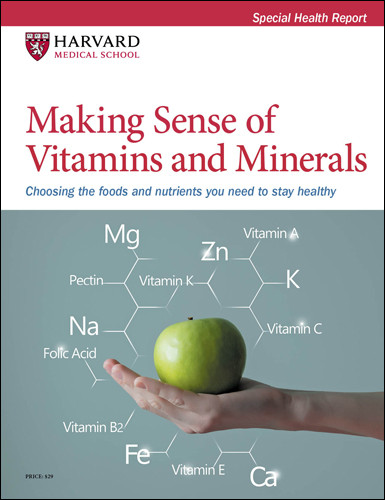Vitamins and Minerals_Test

Making Sense of Vitamins and Minerals
This newly revised Special Health Report explains how to boost your health with the right vitamins and minerals.
If you’re serious about your health, you need to understand vitamins and minerals — the best sources of these nutrients, how your body processes and benefits from them, and the risks to be aware of when you’re getting too many or not enough.
Fortunately, you don’t have to navigate the world of nutrition on your own. Making Sense of Vitamins and Minerals, a Special Health Report from the experts at Harvard Medical School, is here to help you get the right nutrients for a lifetime of good health.
At the core of this information-packed report is a detailed look at the vitamins and minerals most associated with good health and wellbeing.
For each nutrient, Making Sense of Vitamins and Minerals lets you know the Recommended Dietary Allowance, and when it’s OK— and not OK — to surpass the RDA. You’ll also learn which foods contain the highest amounts of each nutrient. In addition, the report tells you when supplements can be beneficial (while emphasizing that getting your nutrients from food is usually your best option).
As you’ll read in Making Sense of Vitamins and Minerals, many foods are rich in other beneficial compounds beyond vitamins: omega-3 fatty acids (found in fish like salmon and tuna, and in flaxseed and walnuts), phytochemicals (a.k.a. bioactives, the compounds in plants that give them their taste, color, and scent), and probiotics (found in fermented foods such as kefir, kombucha, and sauerkraut).
And if you’re a coffee or tea drinker you’ll be happy to learn that your favorite beverages may also deliver some powerful health benefits — you’ll read all about them in the report.
Making Sense of Vitamins and Minerals is brimming with helpful information, such as:
- A “vitamin A to zinc” rundown of the vitamins and minerals you need for your best health
- 20+ nutrient-packed foods that are a great alternative to supplements
- When vitamins and minerals are beneficial — and when they’re not
- A Special Section on how to get the most nutrients out of every meal
- How you could be getting too many — or too few — nutrients, and the effect on your health
Does your diet deliver the daily recommended doses?
In a special section of Making Sense of Vitamins and Minerals, you'll learn how to maximize the amount of nutrients you get from your diet. You’ll discover tips on choosing healthy fats; how to get the right amount of fiber; and way to add fruits and vegetables to your diet. You also get a recipe for a tasty, nutrient-rich smoothie and a sample breakfast, lunch, and dinner menu chock-full of vitamins and minerals.
Understand the nutrients your body needs — order Making Sense of Vitamins and Minerals today!
